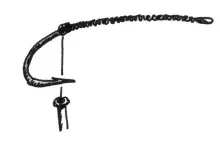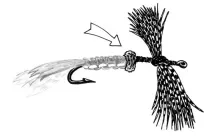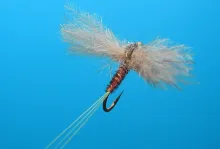Many years ago, when Colombian Carlos Heinsohn began to tie flies, he didn't have more than a few basic materials and not more than three models of hooks. He wanted a huge dragonfly nymph, so he made one almost entirely with black and brown marabou on a #6 hook with a few wraps of copper wire.
This fly is the evolution of one of the first flies I ever tied. Many years ago, when I was beginning to tie flies, I did not have more than a few basic materials and not more than three models of hooks. I wanted a huge dragonfly nymph tied by myself, so I made it almost entirely with black and brown marabou on a #6 hook with a few wraps of copper wire.
The largest one always escapes
The next weekend I went out to fish to a lake. It was my second or third time fishing with a fly rod. I was casting at the shore of a small bay, when suddenly a really large trout took my new fly, perhaps the largest trout I have ever had on the other end of the line.
As soon as it swallowed the fly, the trout came directly at me, hit me on the legs, tangled the line, and ran away.
The ones that escape are always the largest!
Since that day I can’t forget what it feels like when a big trout hit your legs, and how much they like dragon fly nymphs.
Evolution
Since that moment the original fly began to evolve, and in all the models I have developed it has given me good strikes, whenever it maintains certain characteristics of the original one, like the blend of black and brown in the abdomen, the bronze sparkle, the marabou tail, and the legs tied horizontally with brown hackle or marabou, long enough for a good swimming motion.
This fly works great when fished near the shore, especially where grass or other vegetation grows from the water. Does not seem to be a fly for small trout. When I have caught trout with it, they have always been larger than the average of the day.
|
|
|
|
|
|
|
|
|
|
|
|
|
|
|
|
|
|
Use it near the shore, especially in zones where grass and other plants emerge from the water.
I hope you enjoy this fly as I do every time I go fishing to a lake for trout.
Best,
Carlos Heinsohn
- Log in to post comments
























GREAT!! A BIG MONST
GREAT!! A BIG MONSTRUOSITY AS LIKED BY BIG MONSTER FISH...Fly Fishing Mosqueo Tropical in Facebook is proud of you! Good luck with your next creations too!
Hi Ole,
Thanks for
Hi Ole,
Thanks for your words! If you search on Internet for "woven flies" you'll find some tying instructions with illustrations. There is also a website called "crotcheted flies"! I found this technique some years ago on a book, and the results are allways nice.
Those were the first illustrations of a tying process I've made. I'm glad you like them! I hope I can improve with the next ones.
Best,
Carlos
Hallo Carlos,
nic
Hallo Carlos,
nice article and nice fly! I did not understand the weaving completely but maybe I have to try it out and see then if it works or not.
Did you do the drawings on your own? They are really great and making your report different to the ones "just" with photos.
Regards,
Ole